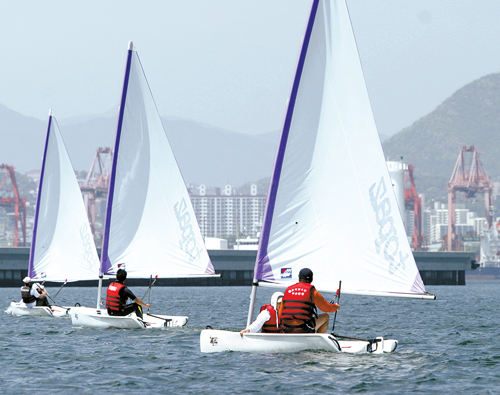Summer sports for everyday adventurers

Students sail out across Busan’s north harbor during a course offered by Korea Maritime University. By Kim Young-ju
“At first I was afraid but now, sailing on my own, I feel like I’m flying over the sea,” said Jang U-geon, a 38-year-old businessman. “I’ve been aboard a cruise ship but this is the first time I’ve piloted a dinghy.”
The people in the boats are students at Korea Maritime University, which has been offering sailing yacht classes since last year.
The boats they are sailing are dinghies, small boats that can be used either for racing or sailing. Learning how to operate a dinghy is a must for beginning seafarers.
“We’ve been giving free lessons with the support of the Busan city government,” said Lee Jae-hyung, a professor at the university. “Last year, there were 140 students enrolled. This year we’ve been offering intermediate-level courses. We also hold yachting competitions for our student sailors.”
With the growing interest in maritime sports in Korea, there are an increasing number of schools offering classes in yachting.
Whether you live near the Han River in Seoul, Suyeong Bay in Busan, or Tongyeong and Goseong in South Gyeongsang, there is a yachting class for everyone.
Yachting is not an easy sport. To do it, people must take a four-day training course before they are permitted to go out on their own.
Students begin by learning about the mechanics of boating in the classroom and then they test their knowledge out on the water. Depending on the weather, yachting can be dangerous, so students also learn safety and rescue techniques.
On the first day of the four-day course there is classroom instruction and a yachting simulation. On day two, students learn how to check the equipment aboard the vessel and how to handle tacking, or aligning the vessel with the direction of the wind. This is a difficult task so there is more instruction on that on day three, when students also learn about jibing, or changing the direction of the vessel with the wind blowing in the opposite direction. The last day is reserved for practice.
“I was afraid of getting too close to the water, but the experience of riding on the wind and floating above the water was fascinating,” said Kim Na-Rae, 26, one of the 15 students in the KMU class.
“You don’t need much physical strength because yachting uses the power of the wind,” said Kang Shin-beum, a KMU instructor. “It’s a good way to spend time with family.”
By Kim Young-ju [jbiz@joongang.co.kr]
Korea Maritime University’s yacht school has four-day classes for beginners and intermediate-level students. The classes are free of charge and continue through October. The university also offers a two-day weekend sailing yacht class for 160,000 won; the class is geared toward people who own sailing yachts but anyone can participate. Students who complete all three courses can be certified as skippers. To register, call (051) 410-4790 or visit http://ocean-ope.hhu.ac.kr.










with the Korea JoongAng Daily
To write comments, please log in to one of the accounts.
Standards Board Policy (0/250자)